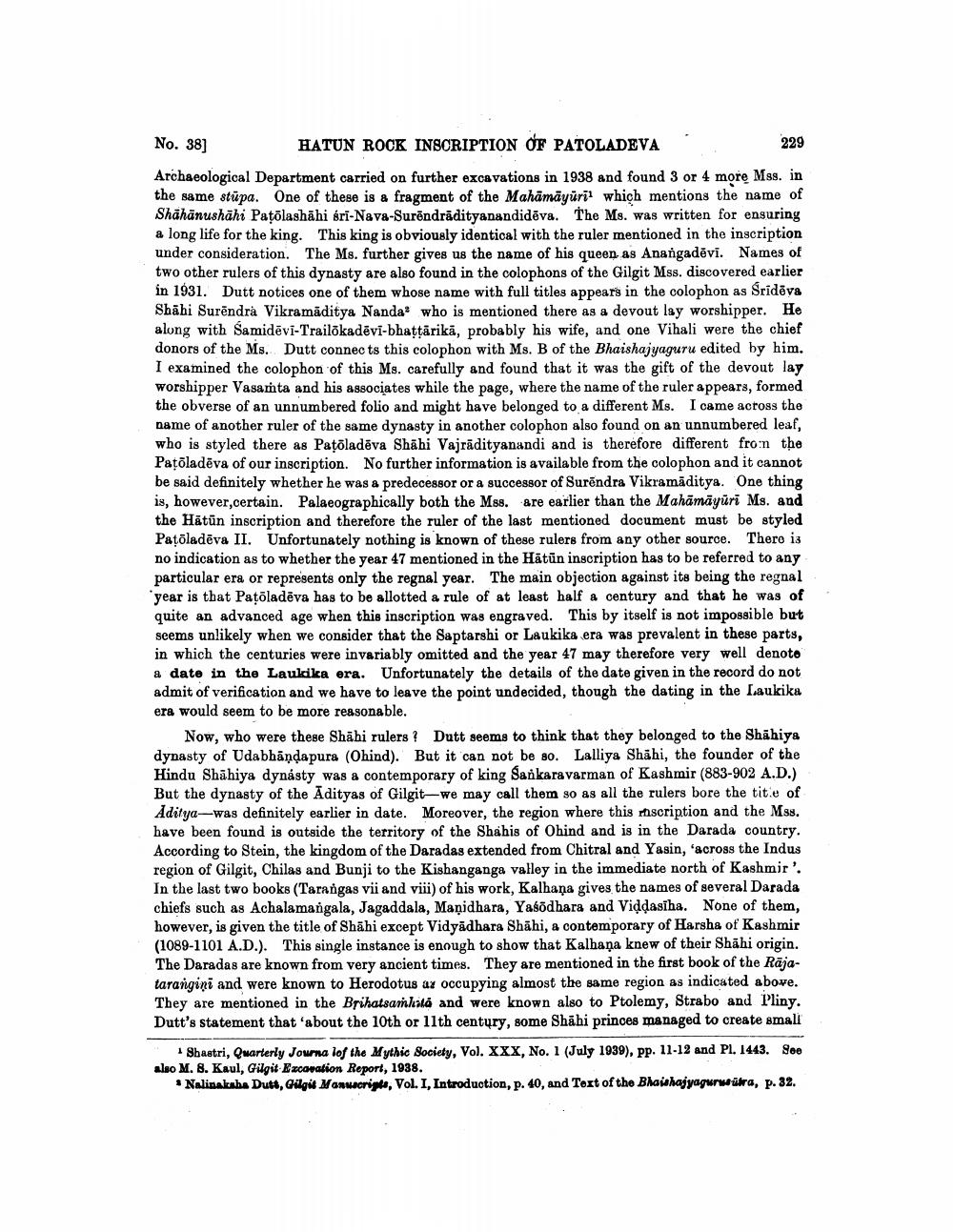________________
No. 38)
HATUN ROCK INSCRIPTION OF PATOLADEVA
229
Archaeological Department carried on further excavations in 1938 and found 3 or 4 more Mss. in the same stupa. One of these is a fragment of the Mahämäyürit which mentions the name of Shähänushähi Patölashähi éri-Nava-Suröndrādityanandidēva. The Ms. was written for ensuring a long life for the king. This king is obviously identical with the ruler mentioned in the inscription under consideration. The Ms. further gives us the name of his queen as Anangadēvi. Names of two other rulers of this dynasty are also found in the colophons of the Gilgit Mss. discovered earlier in 1931. Dutt notices one of them whose name with full titles appears in the colophon as Sridēva Shāhi Surendrà Vikramaditya Nandao who is mentioned there as a devout lay worshipper. He along with Samidēvi-Trailõkadēvi-bhattarikā, probably his wife, and one Vihali were the chief donors of the Ms. Dutt connects this colophon with Ms. B of the Bhaishajyaguru edited by him. I examined the colophon of this Ms. carefully and found that it was the gift of the devout lay worshipper Vasamta and his associates while the page, where the name of the ruler appears, formed the obverse of an unnumbered folio and might have belonged to a different Ms. I came across the name of another ruler of the same dynasty in another colophon also found on an unnumbered leaf, who is styled there as Patöladēva Shāhi Vajrādityanandi and is therefore different froin the Paçõladēva of our inscription. No further information is available from the colophon and it cannot be said definitely whether he was a predecessor or a successor of Surēndra Vikramaditya. One thing is, however,certain. Palaeographically both the Mss. are earlier than the Mahāmāyūri Ms. and the Hätün inscription and therefore the ruler of the last mentioned document must be styled Pațõladēva II. Unfortunately nothing is known of these rulers from any other source. There is no indication as to whether the year 47 mentioned in the Hätün inscription has to be referred to any particular era or represents only the regnal year. The main objection against its being the regnal year is that Patoladēva has to be allotted a rule of at least half a century and that he was of quite an advanced age when this inscription was engraved. This by itself is not impossible but seems unlikely when we consider that the Saptarshi or Laukika era was prevalent in these parts, in which the centuries were invariably omitted and the year 47 may therefore very well denoto a date in the Lauldka era. Unfortunately the details of the date given in the record do not admit of verification and we have to leave the point undecided, though the dating in the Laukika era would seem to be more reasonable.
Now, who were these Shähi rulers ? Dutt seems to think that they belonged to the Shāhiya dynasty of Udabhändapura (Ohind). But it can not be so. Lalliya Shāhi, the founder of the Hindu Shāhiya dynasty was a contemporary of king Sankaravarman of Kashmir (883-902 A.D.) But the dynasty of the Adityas of Gilgit--we may call them so as all the rulers bore the tite of Aditya--was definitely earlier in date. Moreover, the region where this mscription and the Mss. have been found is outside the territory of the Shahis of Ohind and is in the Darada country. According to Stein, the kingdom of the Daradas extended from Chitral and Yasin, 'across the Indus region of Gilgit, Chilas and Bunji to the Kishanganga valley in the immediate north of Kashmir'. In the last two books (Tarangas vii and viii) of his work, Kalhaņa gives the names of several Darada chiefs such as Achalamangala, Jagaddala, Manidhara, Yasödhara and Viddasiha. None of them, however, is given the title of Shāhi except Vidyadhara Shāhi, a contemporary of Harsha of Kashmir (1089-1101 A.D.). This single instance is enough to show that Kalhaņa knew of their Shāhi origin. The Daradas are known from very ancient times. They are mentioned in the first book of the Rājatarangini and were known to Herodotus az occupying almost the same region as indicated above. They are mentioned in the Brihatsamhala and were known also to Ptolemy, Strabo and Pliny. Dutt's statement that 'about the 10th or 11th century, some Shāhi princes managed to create small
Shastri, Quarterly Journa lof the Mythic Society, Vol. XXX, No. 1 (July 1939), pp. 11-12 and Pl. 1443.900 also M. 8. Kaul, Gilgit-Excavation Report, 1938.
Nalinakaha Dutt, Gilgit Manuscripte, Vol. I, Introduction, p. 40, and Text of the Bhaishajyagurwüra, p. 32.




